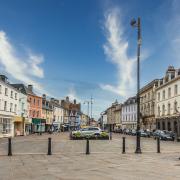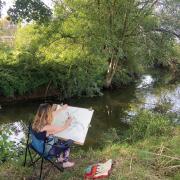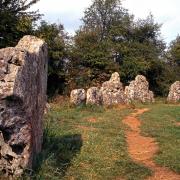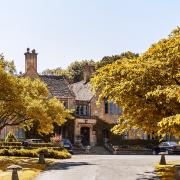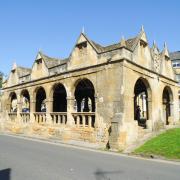Two local artisans talk about castles, cabbages and the colourful history and traditions of canal boat art, and how leisure boating is a great way to discover industrial archaeology en route.
‘Whenever I’m out painting on the towpath, one of the most common things people say is: “Ooh, sign-writing, that’s a dying art”,’ Ginny Barlow chuckles. ‘Actually, it’s doing really well.’ Requests for traditional painted roses for canal boats have increased ever since the Covid pandemic lockdowns, too, she says. ‘Maybe people wanted a bit more brightness in their lives.’
Ginny began her career in sign-writing and traditional boat decoration after going ‘walkabout with travellers’ as a teenager. Living on a boat in Cambridge surrounded by colourful lettering and patterns, she was smitten and took courses in canal boat art and sign-writing.
Ginny and her partner eventually came with their boat to the Kennet & Avon Canal, fell in love with Bradford-on-Avon, and settled on land there. ‘It is such a nice, welcoming community both on and off the water. I love going down to the canal, seeing the wildlife, meeting boaters, and looking at boats.’

FLOWERS & SCUMBLES
Traditional narrow boat decoration flourished during the 19th century when canals offered the quickest inland routes for transporting cargoes, until overtaken by the railways. Boldly painted liveries identified a company’s fleet on the waterways. ‘Number Ones – the owner-boatmen – often had the best decorated boats: for them it was a real pride,’ Ginny says.
With just a tiny back cabin to live in, boating families had little space for personal possessions, and brightened up their surroundings by covering every surface and utensil in geometric designs, playing-card motifs and, most famously, ‘roses and castles’.
‘The exact origins of roses and castles is hazy; floral painting was the popular art of the time,’ Ginny says. The generic term encompassed romantic landscapes, bridges, sailing boats, cottages, mountains and different flora.
‘Roses are very stylised. I also include what I call daisies in a variety of colours, blue, red: round flowers with petals. Obviously, a botanist would have a fit!’
Some regions had recognisable styles of decoration within narrow boat traditions and Ginny has been hunting old photos to see if she can determine historical characteristics for local carriers. ‘I would really like to try and revive something of what was traditional on the Kennet & Avon.’

The majority of Ginny’s customers are leisure boaters, and she works in marinas and local boatyards, as well as canalside, both on modern wide boats and narrow boats.
She particularly enjoys painting traditional signwork in ‘bold, bright, chunky block lettering, with two-tone block shadow, often combined with scrollwork and sometimes roses’. Inside back cabins, she perpetuates the craft of ‘scumbling’, using paint to imitate wood graining:
‘Woodwork in back cabins could be quite bad quality or not uniform, and scumbling gave a clean uniformity. I start by painting a cream or pale-coloured background, then brush on a darker, brown scumble oil – a sort of slow-drying, oily, slightly translucent paint – and work grain patterns into it. There are various tools for the job but I tend to use a piece of scrunched-up paper, and the end of a spoon or a two-pence piece to put in oak figuring. I brush over it lightly again for a more grainy effect.’ A heavy varnish provides a shine.
‘Traditions change but I feel really strongly with canal boat painting that it belonged to the working boat people, and I want to do it as knowledgeably and respectfully as possible,’ she concludes.
Ginny Barlow ginnybarlow.co.uk; Facebook: Ginny Barlow Signwriter; Instagram: barlow.ginny

ROSES & CABBAGES
Katie B Morgan, like Ginny, became interested in canal art as a teenager, in the late 1970s: when she had friends that owned and worked old narrow boats around Braunston and Birmingham. Ian Sly, one of the owners, gave Katie her first set of wood-graining metal combs.
The bustling days of working boats may be gone, but she is pleased to see numerous small businesses taking to the waterways in recent years. ‘Leisure boating is really popular too and people are retiring on boats. So, the traditional decorations, roses and castles, are resurrecting.
‘I know from old photographs that boats on some of the Cotswold Canals didn’t seem to have as much decoration on them as elsewhere, historically, because they were often big flat-bottomed barges and Severn trows,’ she adds.
Katie, of course, is well known to Cotswold Life through her illustrated guides. As a decorative artist she works across different types of folk art, from fairground and gypsy to bargeware, each of which is an art form in its own right, and she enjoys switching between the disciplines.
She has recently been working on traditionally decorated hand-painted and made lino, cans and smaller objects for sale in canalside shops.

‘Roses and castles lend themselves well to small items. It is a basic technique, but everybody has their own style. I love flowers where you can see that someone can really handle a brush, you can see the flow. Flowers are done quite quickly, and you are working wet on wet for some of the shading. A lot of petals are done in one brushstroke – I tend to have an extra “bobble” on mine so that it looks almost like two strokes.’
You can bet none of Katie’s efforts are ‘cabbages’: canal-speak for badly painted roses (you’ll find more such gems in her illustrated book, Words from the Canal). She also says how nice it is that more women are working in canal boat art. ‘It was very male dominated [by the decorators in boatyards], as lots of different crafts were in the distant past.
‘I love walking along our canals, they are so much cleaner now and there is so much wildlife to see,’ she adds. ‘It’s great when you find a bit of industrial archaeology en route – you can learn a lot about industrial history as you are going along.’
Katie B Morgan kbmorgan.co.uk. Katie is Artist in Residence at Nature in Art, October 17-22, natureinart.org.uk
EXPLORING OUR CANALS
The Kennet & Avon Canal, completed in 1810, was restored after a period of decline, and officially re-opened in 1990. From Bradford-on-Avon (where once coal from the Somerset coalfields and other bulky goods like cheeses were handled on the wharves) you can walk or cycle to Avoncliff and Dundas Aqueducts, both designed by John Rennie. At Bradford you can also hire a day boat or join a trip on the Barbara McLellan – regular departures until end of October, while themed trips include Autumn Colours (Oct 17). katrust.org.uk
The Cotswold Canals Trust, which aims to preserve, maintain and improve the Stroudwater Navigation and the Thames & Severn Canal (ie the Cotswold Canals) has visitor centres at Wallbridge Lock (Stroud), Saul Junction and Bond’s Mill (Stonehouse). Together, the canals (completed in 1779 and 1789 respectively) once enabled goods to be transported between the rivers Thames and Severn. Guided walks along the Stroudwater Navigation include Saturdays through September from Wallbridge; public boat trips include departures from Ebley Wharf (Sept 2/16) and Wallbridge Lock (Sept 9/23). Booking advised for all. cotswoldcanals.org/canals




